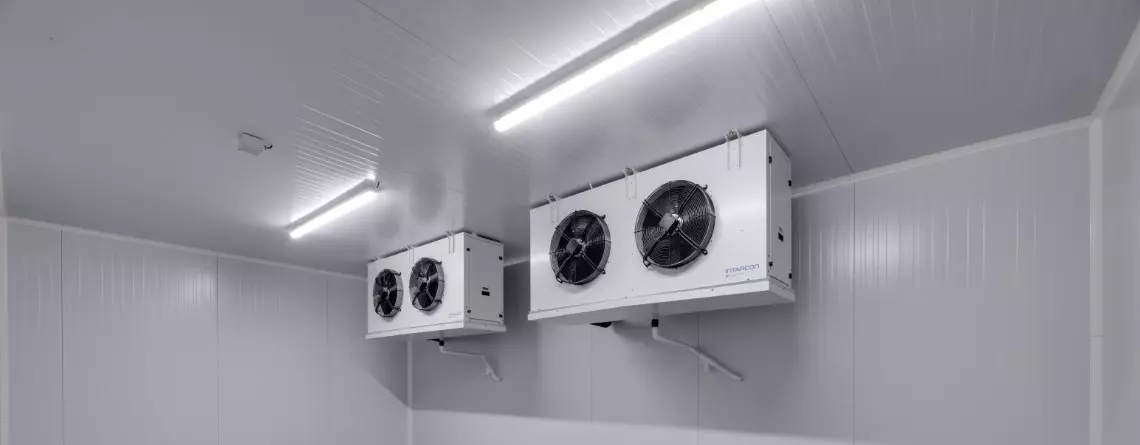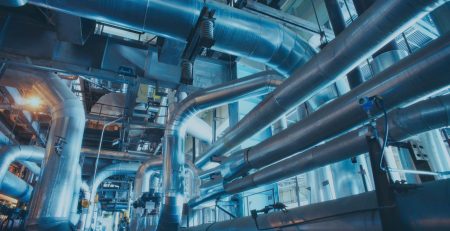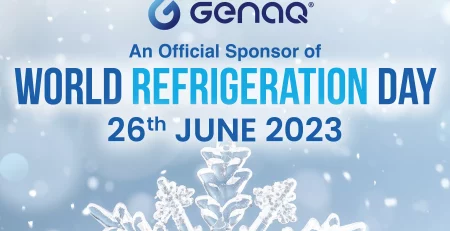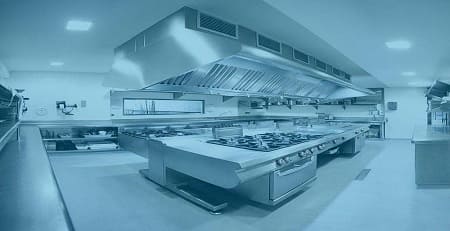Everything you need to know about refrigeration evaporators
INTARCON2022-10-11T12:03:46+02:00Refrigeration evaporators play a fundamental role in any refrigeration or freezing system, whether incorporated in a compact system or as a stand-alone unit. But do you really know what an evaporator is or how it works?
What is a refrigeration evaporator and what is it used for?
In refrigeration, an evaporator is the heat exchanger where the refrigerant circulating inside the refrigeration circuit absorbs the thermal energy from the environment, which is then cooled. This is how the state of the refrigerant changes from liquid to vapour, giving it its name. As a result, the refrigerant evaporates to absorb the temperature or energy from the environment to be cooled.
It function relies on transmitting, as efficiently as possible, the thermal energy from the environment to be cooled (it can be a cold room or a secondary fluid as in the case of indirect refrigeration systems) to the fluid that is evaporating (in this case the main refrigerant).
Types of refrigeration evaporators
We can make different classifications of evaporators; among them, we differentiate:
Depending on the medium to be cooled:
- Air – Refrigerant: these uses in direct expansion systems and in most cold rooms. In these systems, our equipment directly cools the ambient air.
- Refrigerant – Refrigerant: these are mainly used in cascade systems, where the condensing and evaporating temperature differences are very high. This process is mainly carried out in stages, forming two complete refrigeration systems.
- Liquid – Refrigerant: these use when the medium to be cooled is a liquid and are usually used in indirect systems or food refrigeration processes.
Depending on refrigerant outlet conditions:
- Flooded: this type of evaporator uses in two-stage systems with partial or total injection and in systems with a liquid separator at the outlet. In these evaporators, the refrigerant inside the evaporator does not evaporate completely, and at the outlet of the evaporator there is a two-phase mixture with very good heat transfer.
- Dry: These are the most common and are found in most refrigeration installations. In them, the refrigerant evaporates completely inside the evaporator and there is often superheating of the vapour generated.
According to their constructive characteristics:
- Plain: these are common in domestic refrigerators and refrigerated chests. They form the refrigeration circuit itself by joining two metal sheets that have been previously pre-formed so that the refrigerant circulates inside them.
- Tubes and fins: these are common in cold rooms, mainly in refrigerant-air evaporators. The refrigerant evaporates inside the tubes that are in contact with the thin metal sheets.
- Plates: these use in refrigerant-liquid or refrigerant-refrigerant evaporators. Their operation is based on separating both fluids by a copper, aluminium or steel plate, which acts as a conductive agent.
- Uncovered tubes: these use to cool a liquid by installing a bare tube, inside which the refrigerant evaporates.
- Coaxial tubes: these are made up of one or more tubes inside a jacket and are responsible for cooling the liquid.
- Casing – Tubes: very commonly used, in which the refrigerant circulates inside the tubes and the liquid to be cooled circulates inside the casing.
Selection process of a refrigeration evaporator
For a correct selection of a refrigeration evaporator, we must consider a series of factors such as the cooling load required by our refrigeration equipment, the relative humidity, the range, and the air speed required.
In addition, we will have to pay attention to other factors such as the thermal jump, i.e., the temperature difference between the inside of the chamber and the refrigerant used. It is essential to find a balance in the thermal gap because the smaller the thermal gap, the greater the efficiency. In this way, it will work with lower compression rates and the equipment will save energy. However, on the other hand, it will also be more expensive, and the initial investment will be higher.
Nominal power
The power rating of an evaporator affect by the thermal jump, the temperature inside the chamber and the refrigerant used. How do we calculate the nominal power?
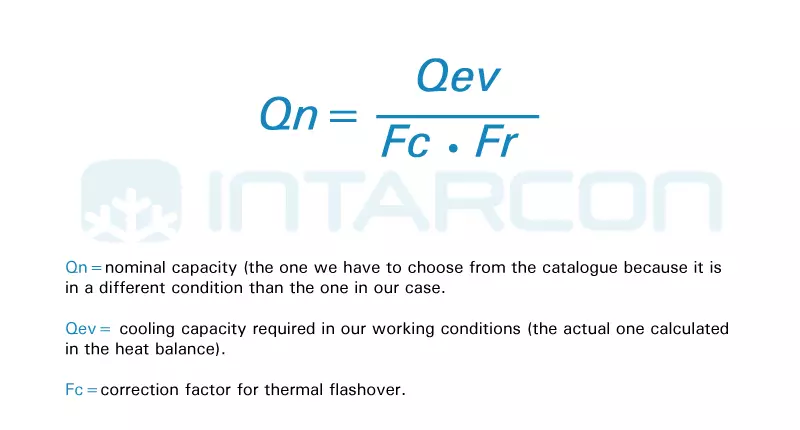
Relative humidity
In addition to this, it is important to know the effect on the relative humidity. Knowing the design evaporating temperature and the working temperature, we will obtain the thermal jump.
As the temperature rise increases, the relative humidity inside the chamber will decrease.
Relative humidity is an important parameter in the design of cold rooms, as each product needs a different relative humidity to be preserved in the best conditions and to conserve all its properties. The most demanding products are mainly fresh products, while in freezing chambers, for example, its role is less relevant.
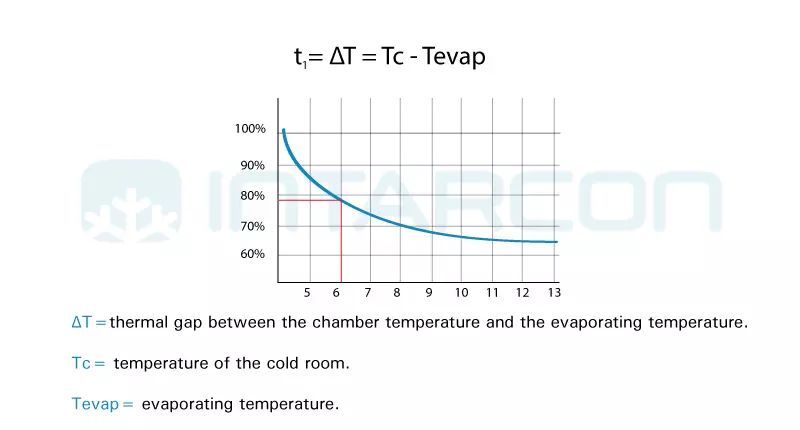
Evaporator power
As we increase the thermal jump, the power transferred will also increase. This occurs because of the behaviour of the heat exchanger and can be explained by the heat transfer equations that model this type of heat exchanger.
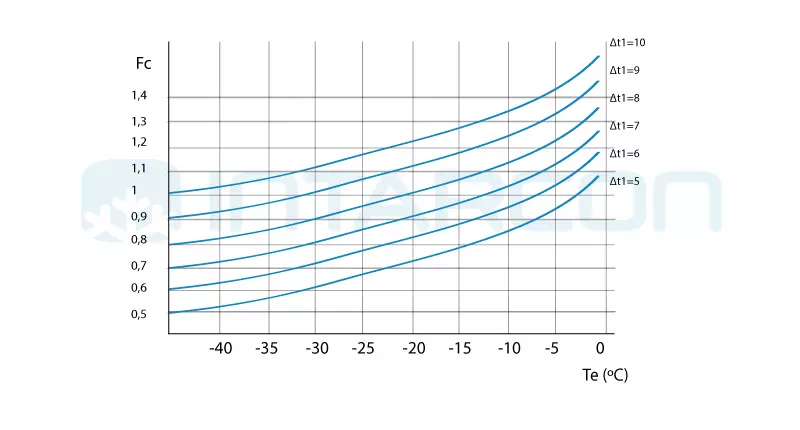
INTARCON has a wide range of refrigeration evaporators based on the maximum efficiency of our equipment, adapted to any type of cold room and to the needs of the products to be cooled. In addition, our range of refrigeration evaporators are available with CO2, NH3, glycol… technologies. Our equipment stands out for incorporating:
- High efficiency coils.
- Integrated expansion and solenoid valves.
- Optimum cooling performance.
- Pre-wired electronic controller (optional).
- Easy access for maintenance and cleaning.
Bibliography
- [1] Own elaboration: INTARCON
- [2] Fundamentals of refrigeration. Chapter 5. Evaporators and Defrosting Systems. Authors: Ángel Barragán Cervera, Joaquín Navarro Esbrí, Francisco Moles, Adrián Mota Babiloni and Bernando Peris.
